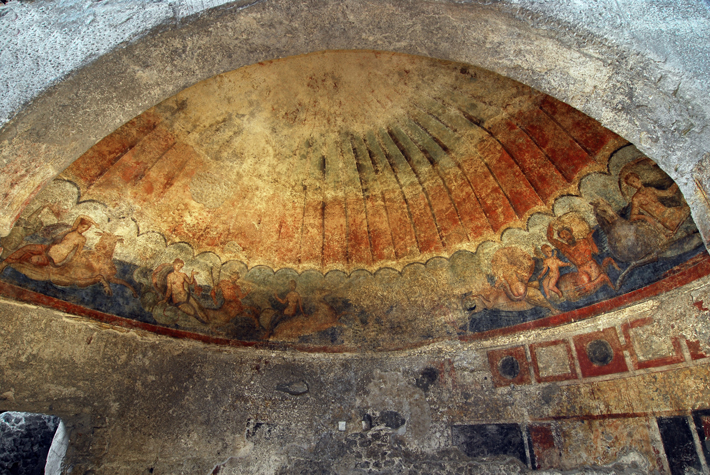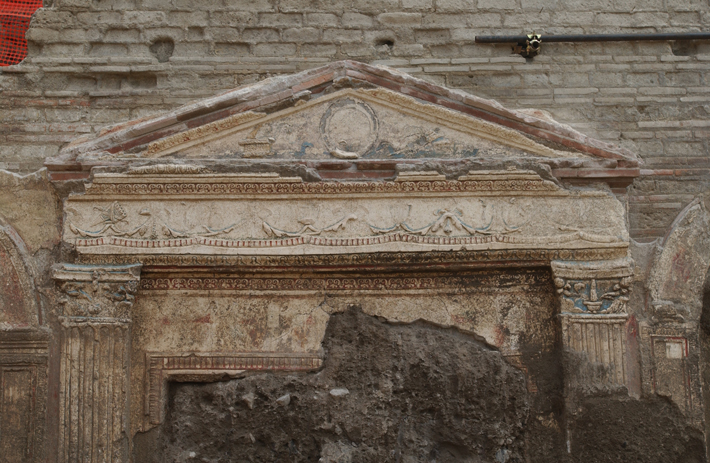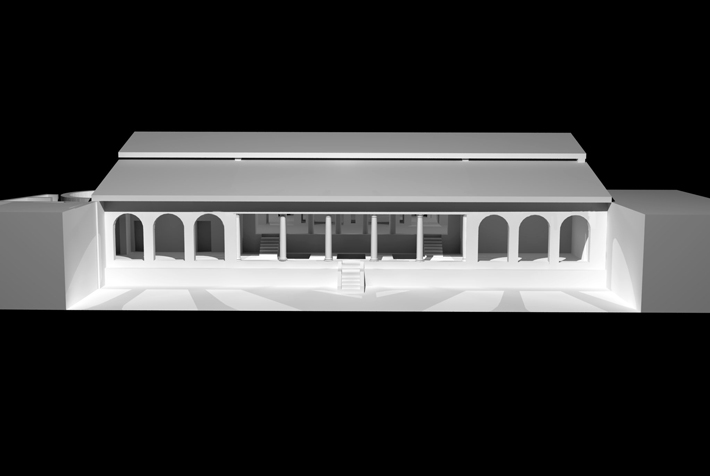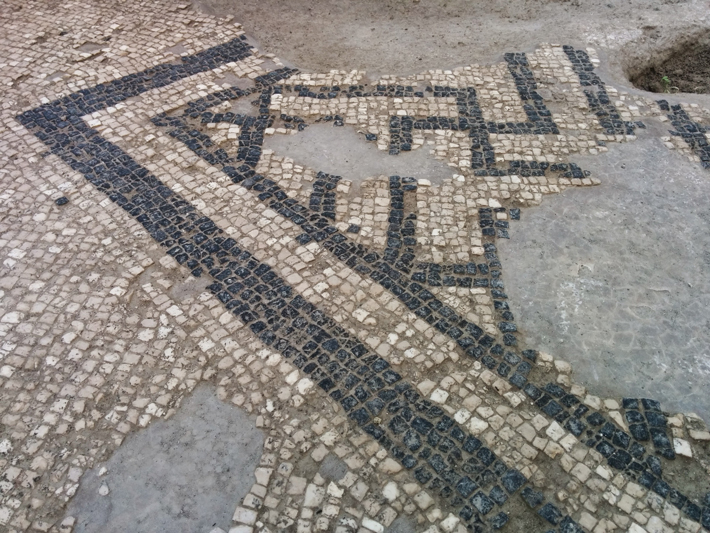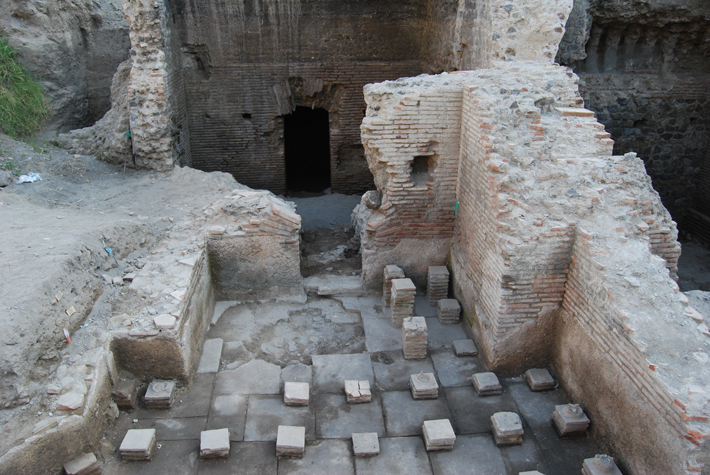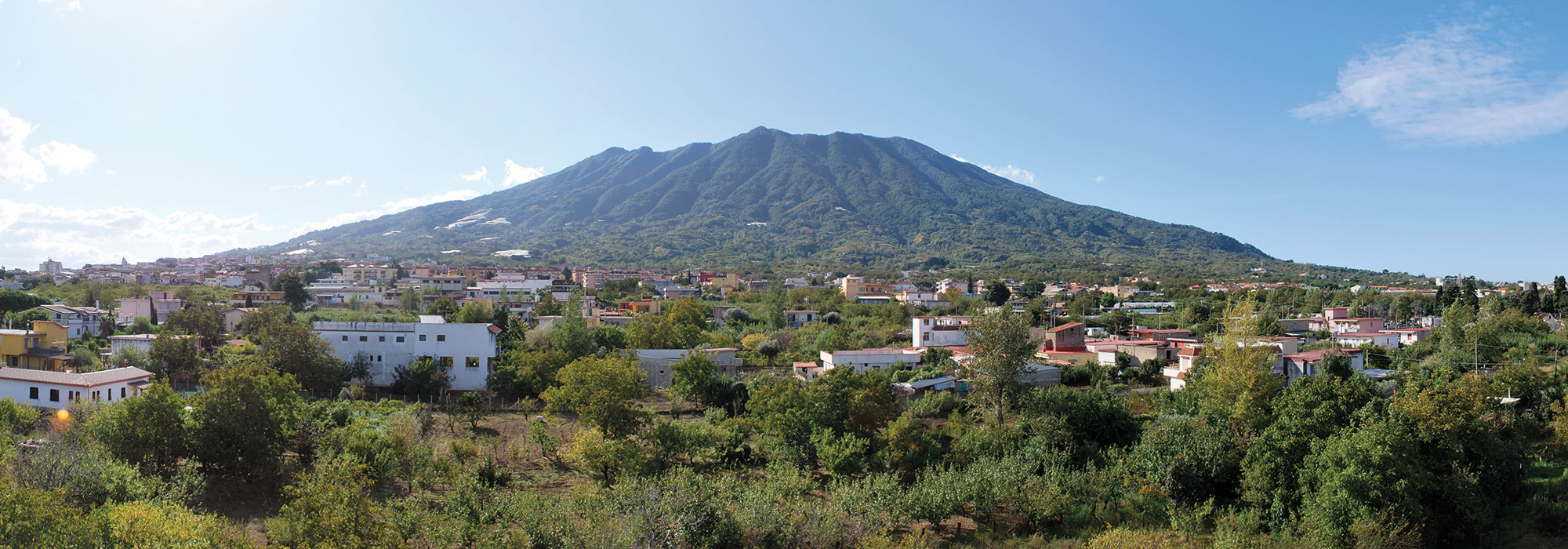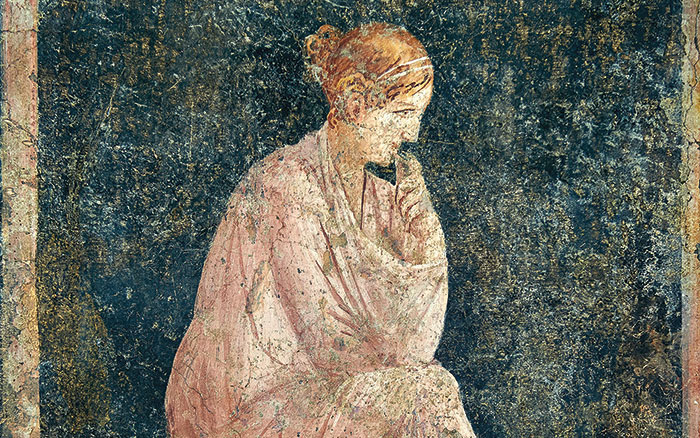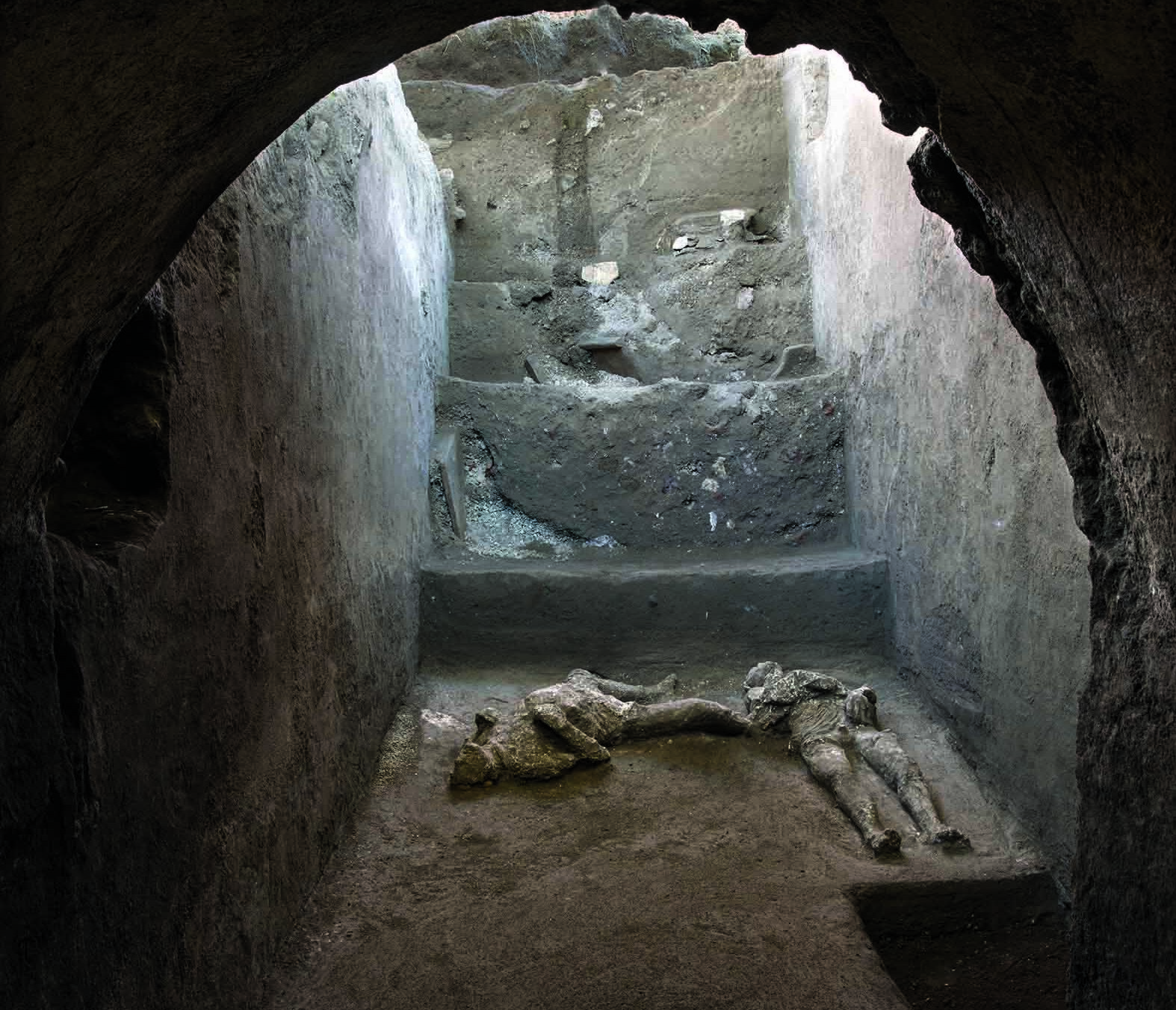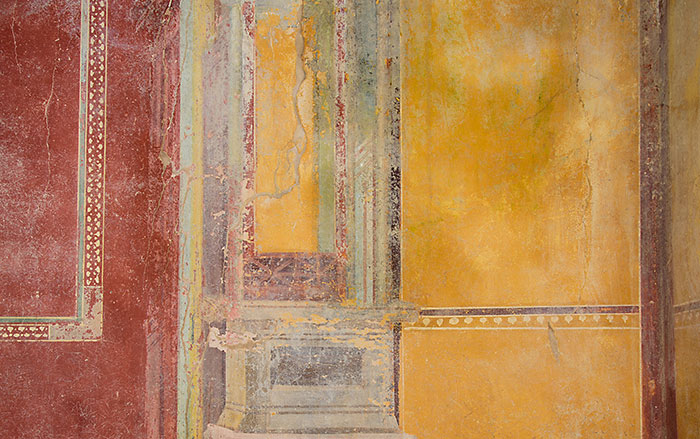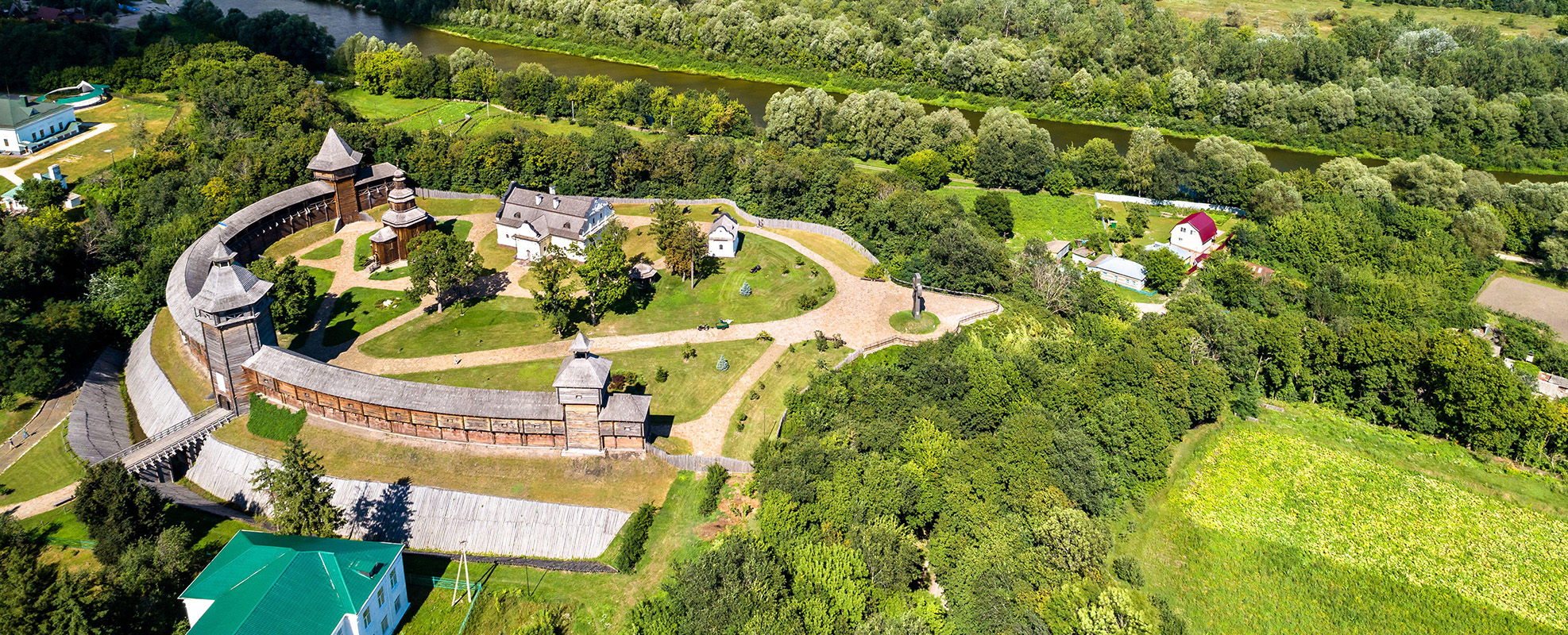
Having reached his mid-seventies, Rome’s first emperor, Caesar Augustus, lived out his final days in a villa near the base of Mount Vesuvius. While traveling in the Bay of Naples, he fell ill and detoured to the ancestral home of his biological father’s family, the Octavii, near the city of Nola. In A.D. 14, at the age of 76, he breathed his last in the same room where his father had died, in the shadow of the great volcano.

The villa’s exact whereabouts were eventually lost. Given its reported proximity to Vesuvius, most archaeologists presumed that the A.D. 79 eruption that destroyed the cities of Pompeii and Herculaneum, along with countless rural villas, had also buried the estate in a deep blanket of volcanic debris. It seemed unlikely that it would ever be discovered. However, in 1929, the director of excavations in Pompeii, Matteo Della Corte, was tipped off by a friend about Roman ruins on the north slope of Vesuvius in the town of Somma Vesuviana, just a few miles from Nola. Although Della Corte’s excavations were brief, a narrow, 30-foot-deep trench revealed a building covered by volcanic ash. Leading volcanologists of the time determined that this destruction layer was a result of the A.D. 79 eruption. The scale of the building, ornate columns, and fragments of expensive marble left the archaeologists in awe. The owner of such an extravagant property must have been someone extraordinarily wealthy, an affluent merchant or perhaps a senator—or even an emperor. Della Corte concluded that, given its location and grandeur, the villa must be the property where the emperor had died, and he named it the Villa of Augustus.
Although this was a seemingly groundbreaking discovery, political turmoil in Italy and lack of funding kept archaeologists away from the site for the rest of the twentieth century. At long last, in 2002, a joint Italian-Japanese team returned to the villa. Not only did the new excavations confirm the existence of a sprawling property, but it was even more extravagant than previously imagined. The team gradually uncovered a monumental entranceway that contained a series of rooms and colonnades built upon three terraces. These spaces were resplendent with colorful frescoes and mosaics, as well as marble statues worthy of the imperial family.
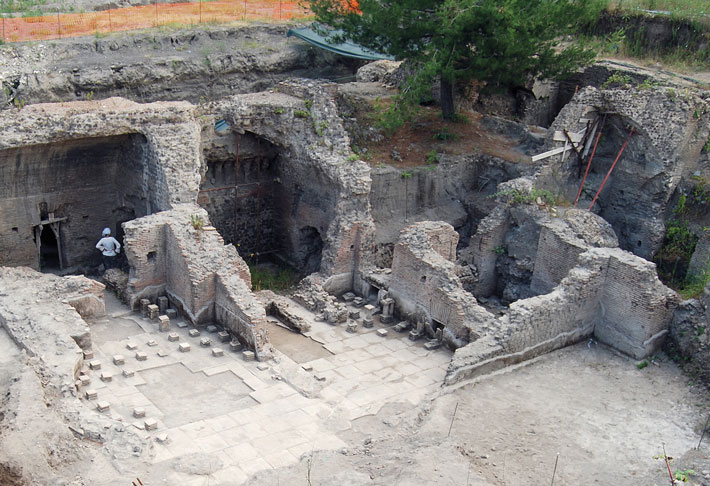
However, the team soon uncovered evidence that turned archaeologists’ interpretation of the site upside down. The volcanic debris that covered the villa did not originate, as previously believed, from the A.D. 79 eruption but from one that occurred four centuries later, in A.D. 472. “It was mind-blowing,” says archaeologist Girolamo Ferdinando De Simone of Suor Orsola Benincasa University, who was part of the team. Even more surprising, it was deemed likely that the grand complex had been constructed in the second century A.D., 100 years after Augustus’ death. This showed that the villa was, in fact, not associated with the emperor. Instead, this meant that it had been built at a time when most scholars believed the area was still largely deserted as a result of the damage of A.D. 79. “In one instant we discovered that the area was not as abandoned as people thought,” says De Simone.
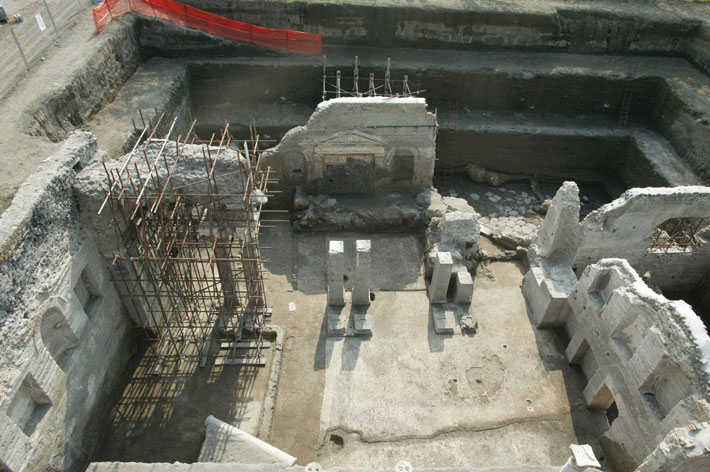
The excavations in Somma Vesuviana have underscored two major gaps in Vesuvian archaeology. First, while sites to the south and west of the volcano, such as Pompeii, Herculaneum, Oplontis, and Stabia, have a long history of excavation and are well publicized, very little work has taken place on the north slope of Vesuvius, an area sometimes referred to as the “dark side.” “It really is the dark side of the volcano because it faces north and is the shady part,” De Simone says, “but also because nobody really cared about what was going on there. For three centuries, no one was excavating on this side of the mountain, and even prominent scholars started thinking that it was probably not that important in antiquity.”

The second gap in knowledge concerns the crucial, but often ignored, question of what happened in the aftermath of the A.D. 79 eruption. For the past two and half centuries, the bulk of Vesuvian fieldwork, research, and scholarly publication has focused on the days that preceded the eruption, the eruption itself, and the devastation it caused in the hardest-hit areas. Questions about the effects of the eruption on other parts of the Bay of Naples, the rebuilding process, and the fate of any survivors have remained largely unstudied. In recent decades, some archaeologists, including De Simone, have begun to address these lacunae, focusing on the years, decades, and centuries after the cataclysmic event. “I’m more interested in what happened the day after the eruption and what happened on the other side of the volcano,” De Simone says.
After the surprising results of the excavations at the Villa of Augustus—the name has persisted despite its inaccuracy—De Simone intensified his research on the north slope of Vesuvius. He wanted to ascertain whether events on the north side played out much the same as they had on the south and west sides. His findings contradict long-held beliefs and show that the north side was no less important or populous in Roman times. De Simone has identified more than 250 Roman-era archaeological sites on the north slope, which is roughly equivalent to the number of sites that have been located elsewhere surrounding the slopes of Vesuvius. Among them is another extensive villa buried by volcanic debris, in the town of Pollena Trocchia. This villa was first uncovered in 1988 by construction workers, but archaeologists didn’t begin to investigate the site until 2006. Since then, they have excavated around a dozen rooms, most of which were part of a large bath complex that belonged to the villa. They also discovered that, like the Villa of Augustus, this building was not buried by the A.D. 79 eruption, but by eruptions in A.D. 472, 505, and 512. It had actually been built directly on top of layers of ash that had fallen in A.D. 79—and not that long after. Pottery stamps on some of the bricks indicate that the villa may have been constructed in the late first century A.D., just a decade or two after the eruption, perhaps the earliest occurrence of rebuilding in the area.
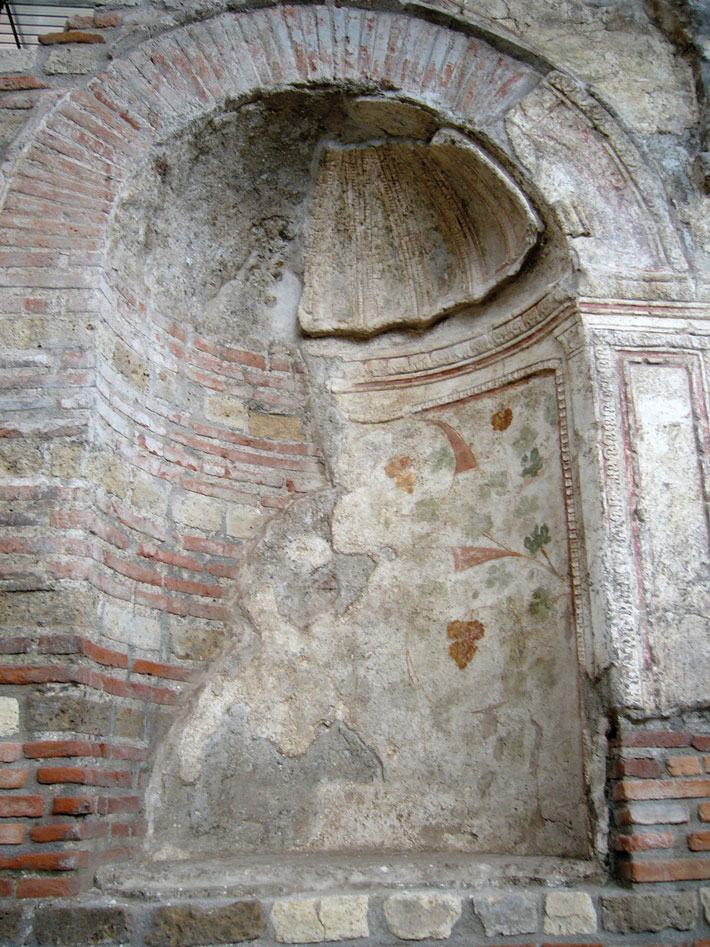
It has become clear over the past two decades that the damage inflicted by Vesuvius in A.D. 79 was not the same on all sides of the mountain. While the cities of Pompeii, to the south, and Herculaneum, to the west, were permanently abandoned, life gradually returned to normal on the other sides of the volcano, in large part thanks to an extensive building program initiated in the years after A.D. 79 and continuing in the centuries that followed. Such a program was able to proceed because the two major cities on Vesuvius’ north side, Nola and Neapolis (modern Naples), suffered mostly from the effects of earthquakes and not the devastating pyroclastic surges that destroyed Pompeii and Herculaneum as well as many other locales. With these two important economic and administrative centers still standing, life could return to relative normalcy in the surrounding countryside. And people were anxious to rebuild and return to the slopes of Vesuvius and its fertile soil, which has kept people living beneath the volcano for thousands of years despite its long history of eruptions.
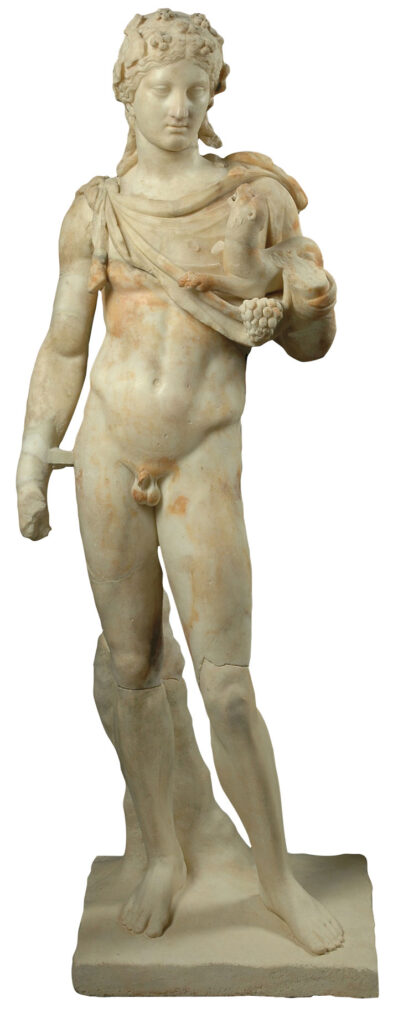
Volcanic soil is full of minerals and nutrients that are beneficial to crops, especially grape vines. Prior to the A.D. 79 eruption, Campania, the Bay of Naples, and the slopes of Vesuvius made up one of the Roman Empire’s most prolific wine-producing regions. The loss of many of the villas around Vesuvius in A.D. 79 provided new economic prospects for those who returned. “This huge catastrophe was also a kind of land of opportunity for some big investors,” says De Simone, “especially in the countryside of Naples and Nola.” In the years before A.D. 79, there were likely many small wine-producing villas scattered across the landscape, but in the decades and centuries that followed, a new kind of “supervilla” was born, of which the properties at Somma Vesuviana and Pollena Trocchia are likely just two examples. Although it is still only partially excavated, if the wine cellar in the Villa of Augustus is as vast as archaeologists project it to be, it would be the largest ever found in Roman Italy. Its walls and ceilings are covered with images associated with wine production, including vines and branches, clusters of grapes, and scenes depicting Dionysus, the Roman god of wine. “He’s everywhere in each room of the entire villa, as a sort of a cultural statement,” De Simone says.
The growth of these villas, along with many others that likely remain undiscovered on the north side of Vesuvius, was to a great extent enabled by the survival of the cities of Nola and Neapolis, both of which continued to be nodes in imperial trade networks. This allowed people to reoccupy the countryside quickly. “Scattered archaeological evidence shows that within about a generation, or maybe two, life was returning to some of these farms,” says University of Texas at Austin archaeologist Rabun Taylor. However, this kind of economic redevelopment could not take place on other sides of Vesuvius since the A.D. 79 eruption had rendered them uninhabitable. Pompeii and Herculaneum had been busy cities, and many people living nearby had business there. With those cities utterly destroyed, where did the survivors go? Were there survivors? Until recently, these questions had been difficult to answer.
There is perhaps no other natural catastrophe in the ancient world that has captured popular attention as intensely as the eruption of Vesuvius in A.D. 79. The destruction of the cities of Pompeii and Herculaneum has been the subject of countless television shows, movies, books, and magazine articles. In many ways, it’s easy to understand why. There are stories embedded there, human moments frozen in time, preserved in the plaster casts of bodies that eerily capture the final contorted poses of some of Vesuvius’ victims.
It makes sense, then, that the popular narrative today tends to focus on death rather than on survival. “The public perception that everybody died is just pervasive,” says Miami University archaeologist Steven Tuck. However, people did escape—many people, in fact—and this is only now beginning to be fully understood. There has always been some indirect archaeological evidence to support this. Out of a combined estimated population of between 15,000 and 25,000 in Pompeii and Herculaneum, the remains of fewer than 2,000 people have been located. Additional indirect evidence, such as the surprising absence of horses in stables, carts on roads, or boats along the harbor, suggests that many people fled to safety using these means of transportation. The eruption also occurred over a two-day period, and those who took decisive action may have been able to escape the lethal surges that struck on the second day. “Thousands of people probably got out of Pompeii and Herculaneum on the first day,” says Taylor. “There were several highways radiating out of Pompeii, and two or three led away from Vesuvius. Those who got out of Herculaneum before the horrific pyroclastic flows there probably made a beeline along the coastal road to Neapolis.”

Tuck was convinced that there must be some way, whether archaeologically or epigraphically, to track down these survivors of the eruption. It is a conundrum that he has grappled with for more than two decades. “It took me fifteen years to figure out how to go about looking for the people in a way that I thought would be conclusive,” Tuck says, “and then about six more years to do the work.” He examined hundreds of inscriptions, epitaphs, pieces of graffiti, and dipinti, or painted inscriptions, that have been found in Pompeii and Herculaneum over the past 250 years. Tuck then compiled a list of all the personal names that appear in those texts dating to between A.D. 50 and 79, theorizing that it was likely that these people lived in the doomed cities when Vesuvius erupted. He then cross-referenced these names with those that appeared in inscriptions found in other Roman cities—but only those that showed up in those cities for the first time in the decades following the eruption. If the name of a well-known individual from Pompeii suddenly turned up in Neapolis for the first time shortly after the eruption, he posited, it was likely that this represented a survivor.
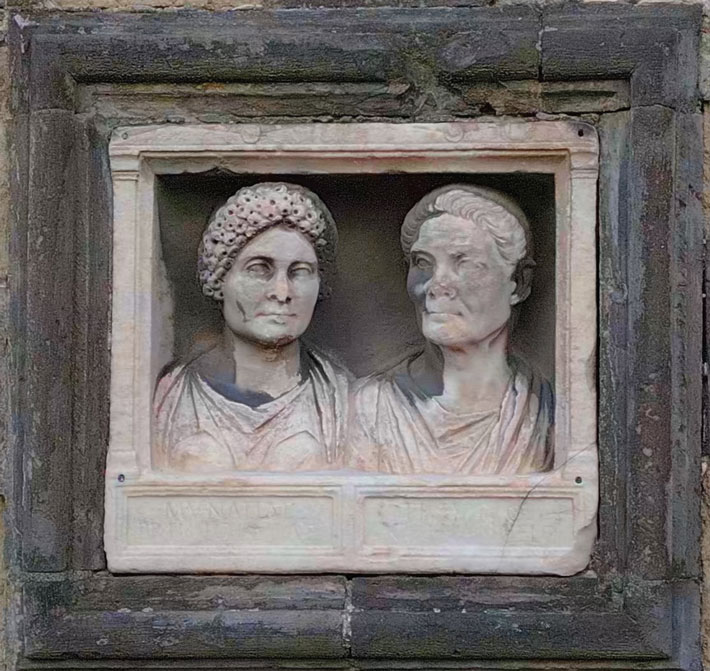
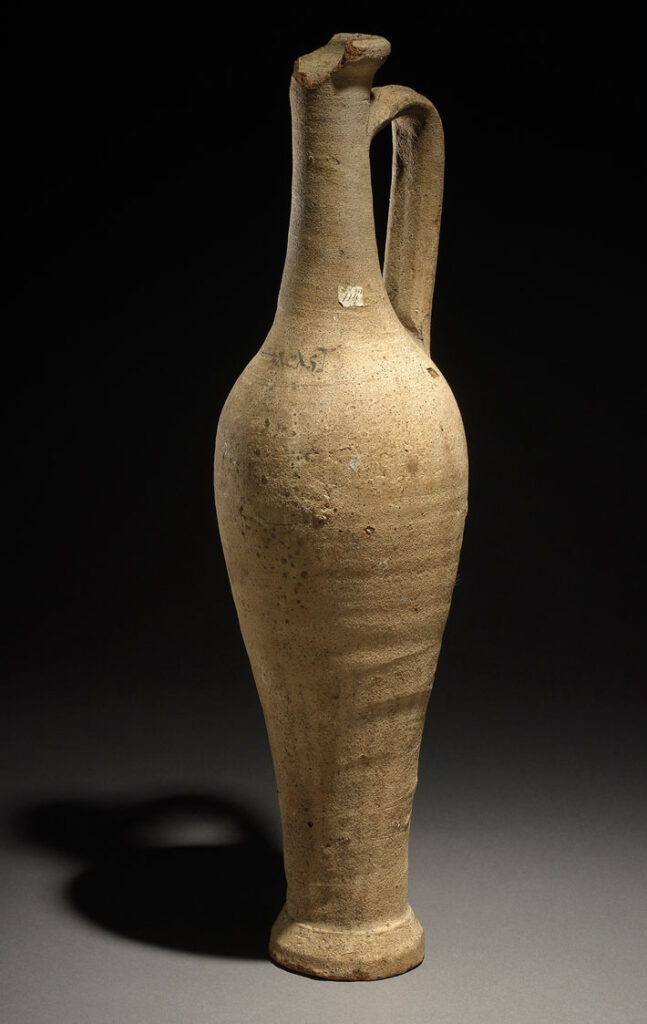
In all, Tuck examined family names from 48 possible Roman refugee cities, focusing especially on settlements around the Bay of Naples. The results were astounding. “I didn’t have a lot of hope that I would find people, so I was shocked—I’m still in disbelief,” he says. “But I can really see where some people went. That’s very exciting.” Tuck’s research produced evidence of around 200 individuals who lived in Pompeii or Herculaneum at the time of the eruption and resettled in a different town afterward. The vast majority migrated to Neapolis, Puteoli (modern Pozzuoli), and Cumae, all towns located on the northern shores of the Bay of Naples. From Pompeii, members of the Aelii, Caecilii, Granii, and Sulpicii families resettled in Cumae. Others, including the Gavii, Herenii, and Fabii, went to Puteoli. One of the clearest examples of refugees settling in a new place is the Umbricii family, who immigrated to Puteoli. The Umbricii were well known in Pompeii for their garum, or fish sauce, business, and their house in the city has been identified by its atrium mosaics depicting garum jars that feature their business slogan. All men in the family were named Aulus Umbricius, and in the years after the eruption, that name appears for the first time in Puteoli, which was a bustling commercial port. Inscriptions on garum jars discovered there reveal that the Umbricii were likely able to transfer their business to their new home. “They used the same wording on their garum containers,” says Tuck. “It’s like any other business that’s really good at branding. They just picked up and used the exact same slogan at the new place.”
Tuck found additional evidence of survivors settling somewhere new by analyzing certain names in detail. Some refugee families added a new cognomen, or third name, to the name of the first child born in their new home to reflect the child’s birthplace. For example, Aulus Umbricius Puteolanus and Marcus Gavius Puteolanus both had the cognomen Puteolanus added to their traditional names. This seems to indicate that they were the first of their families born in Puteoli. The new cognomen was a way for survivors to honor their new home. “It would be like someone moving to the United States and naming their child America,” says Tuck. “It’s a statement about being in this new community and saying, ‘We’re integrating.’”
So many families from Herculaneum seem to have immigrated to Neapolis that they created their own little enclave within the city. An inscription found on a statue base records that it was dedicated to a man named Lucius Munatius Concessianus by the regio primaria splendidissima Herculanensium or “foremost, resplendent district of the Herculaneans.” It seems that when a contingent of Herculaneans fled to Neapolis after the eruption, rather than settling throughout the existing town, they established their own neighborhood in much the same way immigrant communities have established Little Italies or Chinatowns across the globe.
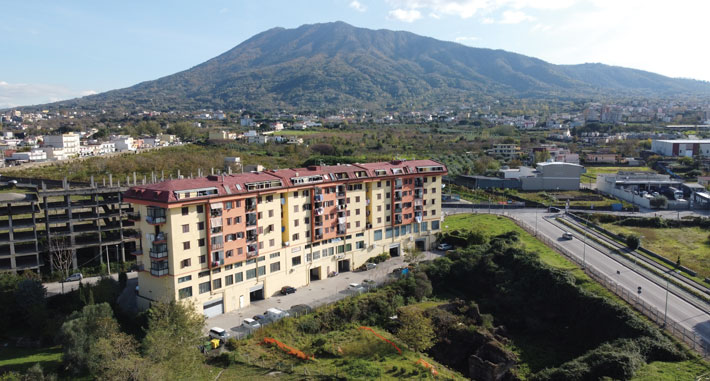
And it wasn’t just wealthy families such as the Umbricii who were able to make it out alive. Tuck has found evidence that a few Pompeian families of lesser socioeconomic status, such as the Atilii and the Masuri, made their way to Nuceria, a town around 10 miles southeast of Pompeii. An epitaph found in a tomb there also draws attention to the humanitarian crisis the eruption caused and how surviving individuals tried to take care of one another in its aftermath. The tomb belonged to a young man named Avianius Felicio but was erected by the Masuri family. In the inscription, Felicio is labeled as an alumnus, a word used to denote someone who was adopted into foster care. It is a term that has never been found in an inscription anywhere in Pompeii or Herculaneum, as orphans by law were always taken in by whatever extended family existed in the area. Given the circumstances, Tuck believes it is likely that the young Felicio lost his entire family in the eruption and was subsequently adopted by the Masuri. “This child has to have nobody, and he’s fostered to another Pompeian family of survivors at Nuceria,” he says. “They had gotten out and took him in before he died, at what looks to be a young age.”
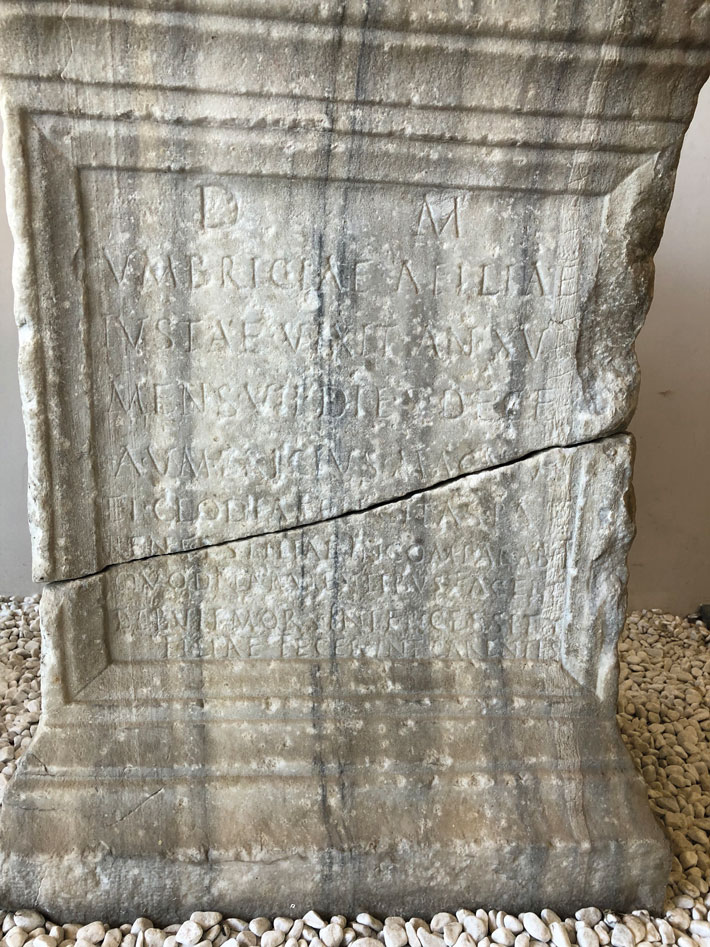
Tuck’s study has been very successful in locating survivors of the A.D. 79 eruption, but he estimates that the names he has identified represent just a tiny fraction of the overall number of people who successfully fled Vesuvius’ wrath. “I think a lot of people got out, at least 10,000 from both cities altogether,” he says. “There’s a lot of evidence for this.” These sudden waves of immigration would have undoubtedly caused logistical and economic problems for the towns that took them in. Some of these issues were tackled by the Roman government and by the emperor Titus (reigned A.D. 79–81), who visited the devastated Vesuvian region shortly after the eruption to assess the situation on the ground. “What’s most remarkable to me is that Titus took extraordinary measures to stabilize the local economy, buying up devastated properties at pre-disaster prices,” says Taylor. “He clearly believed—or pretended to believe—that the area could be redeemed. And eventually it was, at least to some degree.”

In the decades that followed the A.D. 79 eruption there was a tremendous building boom in the surviving cities in the Bay of Naples that was likely necessitated by the stream of new inhabitants. A major road, the Via Domitiana, was built to connect Cumae with the Via Appia, Roman Italy’s most important thoroughfare. The city was also provided with a new aqueduct, baths, and temples, and its forum underwent a major renovation and expansion. Puteoli, likewise, was developed with new roads, buildings, and markets. Its amphitheater was doubled in size, making it the third largest in the Roman world. Not only did the population influx into these new communities require new infrastructure, the building boom also provided job opportunities for many displaced people. “There was a lot of money getting poured into the north side of the Bay of Naples,” says Tuck. “To me, it’s really interesting to see government responding and, I think, following the movements of survivors.”
The image of a fiery Vesuvius enveloping the countryside and destroying everything in its path has become deeply ingrained in the popular imagination—and that certainly is part of the story. But it is also a story of survival and of resilience. “The irony is that the survivors’ voices didn’t last beyond a few generations,” says Taylor, “whereas the bodies of the dead are still around to telegraph their grisly tales.”
These new tales of survival and immigration are slowly beginning to emerge from the ashes. “I do understand why the general public likes the old story because it’s very appealing, a sort of Shakespearean tragedy in which everybody dies,” says De Simone. “It’s a beautiful final scene for a movie, but there’s a sequel, and we have seen that this sequel happens all the time with human beings and natural catastrophes. Why shouldn’t it be the same here?”
Slideshow: Lost Villas of Vesuvius
Here are some additional images of the villas. Credit for all images: Courtesy Girolamo F. De Simone.
